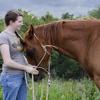Different genes or just expression?
Forums
I've actually wondered the
I've actually wondered the exact same thing CM. I've thought they may more likely be a darker form of dun since there are 'lobo duns' who look almost black found in horse. Too bad donkey dun doesn't have a test yet. I hope Pet DNA Servises of AZ make more donkey gene tests. I still find it nifty that they have a test for NLP versus Pangare.
Also wondering about Frosty and Roan apparently being able to express with one dose on black bases but needing 2 to express on red bases. I don't know how that would work. I understand sex-linked genes with males only needing one dose of a sex linked gene and females needing two, but I've never heard this with base colors.
Another thing I wonder is with the spotted pattern not being common on red bases. But that could be explained by being very closely linked to E at extension.
What would cause the white
What would cause the white looking ones with the cross>
One of our donkeys is a dark grulla colored boy and the other is white with a blue/gray cross.
Sorry the picture is so crappy
[IMG]http://i167.photobucket.com/albums/u146…]
Those are two of our black silver RMH's in the back, we have three and they're all different shades. I'm fairly convinced Rio is actually cream on black silver... may have to send in a test for him.
They are all shed out now and the other two are DARK, he's still pretty light.
The best families that I can
The best families that I can study are mini donkey breeding farms, they are usually pretty good about showing sire,dam and their offspring, and sometimes even grandparents.
Threnody, I think that is old information but I'll have to do some new looking into about it.
Jordie, I would say that the pangare on the lighter donkey is helping to make the lower half so white, but I would also bet there is roaning going on, making it roan and dun, but closer pictures would be needed.
Everywhere I've searched says
Everywhere I've searched says that about the mixed white patterns in donkeys and I agree it just sounds wonky and not likely. I'm thinking they might also be close to the extension locus and cause more black based ones than red based. Maybe not as close as spotted is the the extension, but enough to offset expected ratios of offspring.
And I agree the one donkey looks likely gray dun with roaning.
So are you saying that roan
So are you saying that roan is linked to black with a very low crossover rate? Unlike spotting which is with black with no known crossover. The "star" gene does not seem to be linked to any particular color, and I honestly cant remember about frosting
Here is a red dun roan just to look at
http://www.eveningstarranch.com/assets/…
http://www.lazybspotteddonkeys.com/wp/w…
compared to a more common brown roan
http://www.littlefriendsranch.com/Thelm…
and a blue roan
http://www.lazybspotteddonkeys.com/wp/w…
It's the only thing that
It's the only thing that would make sense to me. I don't know how else a pattern can be "recessive" on red and "dominant" on black. Plus red pigment doesn't suppress white expression as much when compared to black so one would think it isn't a case of a pattern being present but suppressed.
If roan is more commonly linked to E it would solve part of the problem of it mainly being seen on black bases. Of course this is all just theory in attempting to make sense of something that doesn't fit into normal genetic inheritance by description alone.





I admittedly don't know much
I admittedly don't know much about donkey/mule color genetics, but it would seem to me that it would just be a difference in expression. Similar to chestnuts, and even bays, or fading and non fading black.